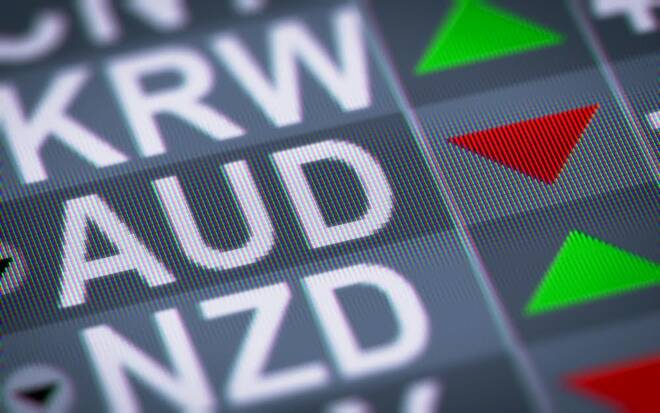Advertisement
Advertisement
Weaker Risk Appetite, Higher US Yields Pressure Aussie, Kiwi
By:
The Aussie has been building a support base since mid-December amid increased bets the RBA will wind down its pandemic-era bond buying in early 2022.
The Australian and New Zealand Dollars fell on Friday amid renewed demand for the U.S. Dollar as the recent selling spree driven by the view that Federal Reserve tightening moves were largely priced in abated, and as weaker risk appetite in financial markets led investors to shun riskier currencies like the Aussie and Kiwi.
On Friday, the AUD/USD settled at .7217, down 0.0063 or -0.87% and the NZD/USD finished at .6812, down 0.0052 or -0.76%. The Invesco CurrencyShares Australian Dollar Trust closed at $72.18, up $0.02 or +0.03%.
The Aussie and Kiwi still managed to post a gain for the week despite Fed Chair Jerome Powell saying that the U.S. economy is ready for the start of tighter monetary policy and data showing the largest annual rise in inflation in nearly four decades.
Weaker global stock markets and higher Treasury yields also weighed on the Australian and New Zealand Dollar’s appeal as liquid proxies for risk appetite.
Aussie, Kiwi Traders Shrug-Off Powell’s Hawkish Comments
The Aussie and Kiwi were supported throughout the week as traders disregarded hawkish comments from Fed Chair Jerome Powell. It should be made clear, however, that investors weren’t buying the two currencies because of strengthening domestic fundamentals, but rather because of a massive liquidation of the U.S. Dollar.
Federal Reserve Chairman Jerome Powell, with a seemingly clear path to a second term heading the central bank, declared Tuesday that the U.S. economy is both healthy enough and in need of tighter monetary policy.
As part of his confirmation hearing before the U.S. Senate Committee on Banking, Housing and Urban Affairs, Powell said he expects a series of interest rate hikes this year, along with other reductions in the extraordinary help the Fed has been providing during the pandemic era.
“As we move through this year…if things develop as expected, we’ll be normalizing policy, meaning we’re going to end our asset purchases in March, meaning we’ll be raising rates over the course of the year,” he told committee members. “At some point perhaps later this year we will start to allow the balance sheet to run off, and that’s just the road to normalizing policy.”
Short-Term Outlook
Powell’s testimony offered no surprises and were likely already priced into the Australia and New Zealand Dollars. Looking at the current timeline, the Fed tipped their hand on a rate hike at its mid-December meeting. The Fed minutes released in early January confirmed policymakers were willing to get more aggressive with policy and Tuesday’s comments from Powell confirmed this news.
The AUD/USD has been building a support base since December 15. The move is being fueled by strong domestic jobs data and increased bets that the Reserve Bank of Australia (RBA) will wind down its pandemic-era bond buying early next year. Essentially following in the footsteps of the U.S. Federal Reserve.
The short-term focus is likely to be on the RBA’s next meeting, scheduled for February 1 with traders wondering how much of an effect the Omicron outbreak will have on monetary policy decisions.
For a look at all of today’s economic events, check out our economic calendar.
About the Author
James Hyerczykauthor
James Hyerczyk is a U.S. based seasoned technical analyst and educator with over 40 years of experience in market analysis and trading, specializing in chart patterns and price movement. He is the author of two books on technical analysis and has a background in both futures and stock markets.
Advertisement
